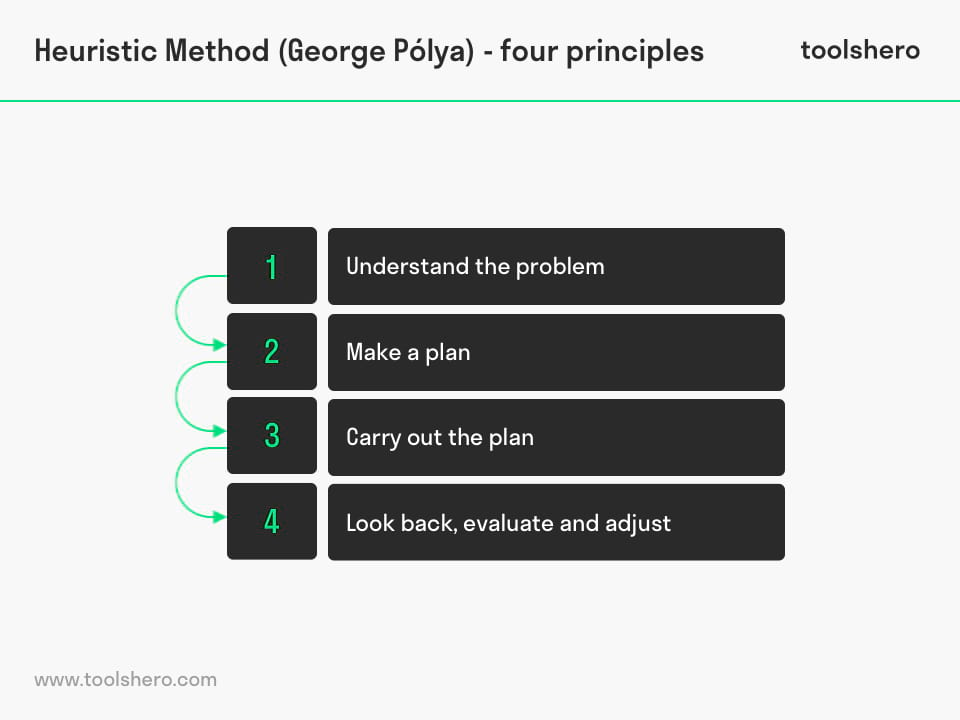Heuristic Method

Heuristic Method: this article explains the concept of the Heuristic Method, developed by George Pólya in a practical way. After reading it, you will understand the basics of this powerful Problem Solving tool.
What is the Heuristic Method?
A heuristic method is an approach to finding a solution to a problem that originates from the ancient Greek word ‘eurisko’, meaning to ‘find’, ‘search’ or ‘discover’. It is about using a practical method that doesn’t necessarily need to be perfect. Heuristic methods speed up the process of reaching a satisfactory solution.
Previous experiences with comparable problems are used that can concern problem situations for people, machines or abstract issues. One of the founders of heuristics is the Hungarian mathematician György (George) Pólya, who published a book about the subject in 1945 called ‘How to Solve It’. He used four principles that form the basis for problem solving.
Heuristic method: Four principles
Pólya describes the following four principles in his book:
- try to understand the problem
- make a plan
- carry out this plan
- evaluate and adapt
If this sequence doesn’t lead to the right solution, Pólya advises to first look for a simpler problem.
A solution may potentially be found by first looking at a similar problem that was possible to solve. With this experience, it’s possible to look at the current problem in another way.
First principle of the heuristic method: understand the problem
It’s more difficult than it seems, because it seems obvious. In truth, people are hindered when it comes to finding an initially suitable approach to the problem.
It can help to draw the problem and to look at it from another angle. What is the problem, what is happening, can the problem be explained in other words, is there enough information available, etc. Such questions can help with the first evaluation of a problem issue.
Second principle of the heuristic method: make a plan
There are many ways to solve problems. This section is about choosing the right strategy that best fits the problem at hand. The reversed ‘working backwards’ can help with this; people assume to have a solution and use this as a starting point to work towards the problem.
It can also be useful to make an overview of the possibilities, delete some of them immediately, work with comparisons, or to apply symmetry. Creativity comes into play here and will improve the ability to judge.
Third principle of the heuristic method: carry out the plan
Once a strategy has been chosen, the plan can quickly be implemented. However, it is important to pay attention to time and be patient, because the solution will not simply appear.
If the plan doesn’t go anywhere, the advice is to throw it overboard and find a new way.
Fourth principle of the heuristic method: evaluate and adapt
Take the time to carefully consider and reflect upon the work that’s already been done. The things that are going well should be maintained, those leading to a lesser solution, should be adjusted. Some things simply work, while others simply don’t.
Heuristics
There are many different heuristic methods, which Pólya also used. The most well-known heuristics are found below:
1. Dividing technique
The original problem is divided into smaller sub-problems that can be solved more easily. These sub-problems can be linked to each other and combined, which will eventually lead to the solving of the original problem.
2. Inductive method
This involves a problem that has already been solved, but is smaller than the original problem. Generalisation can be derived from the previously solved problem, which can help in solving the bigger, original problem.
3. Reduction method
Because problems are often larger than assumed and deal with different causes and factors, this method sets limits for the problem in advance. This reduces the leeway of the original problem, making it easier to solve.
4. Constructive method
This is about working on the problem step by step. The smallest solution is seen as a victory and from that point consecutive steps are taken. This way, the best choices keep being made, which will eventually lead to a successful end result.
5. Local search method
This is about the search for the most attainable solution to the problem. This solution is improved along the way. This method ends when improvement is no longer possible.
Exact solutions versus the heuristic method
The heuristic approach is a mathmatical method with which proof of a good solution to a problem is delivered. There is a large number of different problems that could use good solutions. When the processing speed is equally as important as the obtained solution, we speak of a heuristic method.
The Heuristic Method only tries to find a good, but not necessarily optimal, solution. This is what differentiates heuristics from exact solution methods, which are about finding the optimal solution to a problem. However, that’s very time consuming, which is why a heuristic method may prove preferable. This is much quicker and more flexible than an exact method, but does have to satisfy a number of criteria.
Firstly, the heuristic solution must offer a reasonable calculation effort. Secondly, there must be a high probability that the solution is feasible (optimal functioning) and, lastly, the chance of the creation of a bad solution must be minimal.
It’s Your Turn
What do you think? Is the Heuristic Method applicable in your personal or professional environment? Do you recognize the practical explanation or do you have more suggestions? What are your success factors for solving problems
Share your experience and knowledge in the comments box below.
More information
- Groner, R., Groner, M., & Bischof, W. F. (2014). Methods of heuristics. Routledge.
- Newell, A. (1983). The heuristic of George Polya and its relation to artificial intelligence. Methods of heuristics, 195-243.
- Polya, G. (2014, 1945). How to solve it: A new aspect of mathematical method. Princeton university press.
How to cite this article:
Mulder, P. (2018). Heuristic Method. Retrieved [insert date] from ToolsHero: https://www.toolshero.com/problem-solving/heuristic-method/
Add a link to this page on your website:
<a href=”https://www.toolshero.com/problem-solving/heuristic-method/”>ToolsHero: Heuristic Method</a>
Published on: 29/05/2018 | Last update: 04/03/2022







